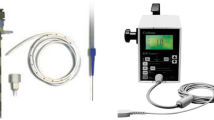Abstract
Introduction
Dexmedetomidine is a centrally acting α2-adrenergic agonist which is currently FDA-approved for the short-term (less than 24 h) sedation of adults during mechanical ventilation.
Discussion
Given its beneficial physiologic properties, there has been increasing use of this agent in the pediatric population. As with any agent used for sedation in the Pediatric ICU setting, dose escalations may be necessary. Unlike benzodiazepines and opioids, there are limited data regarding the administration of dexmedetomidine above the current package insert dosing recommendations of 0.7 μg/kg/h.
Results
We report a 2-year-old child with traumatic brain injury who developed hypertension following the administration of a dexmedetomidine infusion at 4 μg/kg/h for several hours. Investigation into the etiology of the hypertension was negative and the blood pressure returned to baseline with a decrease in the infusion rate.
Conclusion
Subsequent to this, no further issues with hypertension were noted.
Similar content being viewed by others
References
Virtanen R, Savola JM, Saano V, Nyman L. Characterization of selectivity, specificity, and potency of medetomidine as an alpha2-adrenoceptor agonist. Eur J Pharmacol. 1998;150:9–14.
Tobias JD. Dexmedetomidine: applications in pediatric critical care and pediatric anesthesiology. Pediatr Crit Care Med. 2007;8:115–31.
Bloor BC, Ward DS, Belleville JP, et al. Effects of intravenous dexmedetomidine in humans, II: hemodynamic changes. Anesthesiology. 1992;77:1134–42.
Venn RM, Bradshaw CJ, Spencer R, et al. Preliminary UK experience of dexmedetomidine, a novel agent for postoperative sedation in the intensive care unit. Anaesthesia. 1999;54:1136–42.
Talke P, Tong C, Lee HW, et al. Effect of dexmedetomidine on lumbar cerebrospinal fluid pressure in humans. Anesth Analg. 1997;85:358–64.
Zornow MH, Scheller MS, Sheehan PB, Strant MAP, Matsumoto M. Intracranial pressure effects of dexmedetomidine in rabbits. Anesth Analg. 1992;75:232–7.
Karlsson BR, Forsman M, Roald OK, et al. Effect of dexmedetomidine, a selective and potent α2-agonist, on cerebral blood flow and oxygen consumption during halothane anesthesia in dogs. Anesth Analg. 1990;71:125–9.
Prielipp RC, Wall MH, Tobin JR, et al. Dexmedetomidine-induced sedation in volunteers decreases regional and global cerebral blood flow. Anesth Analg. 2002;95:1052–9.
Aryan HE, Box KW, Irahim D, et al. Safety and efficacy of dexmedetomidine in neurosurgical patients. Brain Inj. 2006;20:791–8.
Tobias JD, Berkenbosch JW. Sedation during mechanical ventilation in infants and children: dexmedetomidine versus midazolam. South Med J. 2004;97:451–5.
Drummond JC, Dao AV, Roth DM, et al. Effect of dexmedetomidine on cerebral blood flow velocity, cerebral metabolic rate, and carbon dioxide response in normal humans. Anesthesiology. 2008;108:225–32.
Guidelines for the acute medical management of severe traumatic brain injury in infants, children, and adolescents. Use of sedation and neuromuscular blockade in the treatment of severe pediatric traumatic brain injury (chapter 9). Pediatr Crit Care Med. 2003;4:S34–7.
Spitzfaden AC, Jimenez DF, Tobias JD. Propofol for sedation and control of intracranial pressure in children. Pediatr Neurosurg. 1999;31:194–200.
Wheeler A, Bothwell M, Tobias JD. Prevention of medication withdrawal following laryngotracheoplasty. Am J Pain Manage. 2005;15:15–21.
Hammer GB, Philip BM, Schroeder AR, et al. Prolonged infusion of dexmedetomidine for sedation following tracheal resection. Pediatr Anesth. 2005;15:616–20.
Chrysostomou C, Zeballos T. Use of dexmedetomidine in a pediatric heart transplant patient. Pediatr Cardiol. 2005;26:651–4.
Chrysostomou C, Di Filippo S, Manrique AM, et al. Use of dexmedetomidine in children after cardiac and thoracic surgery. Pediatr Crit Care Med. 2006;7:126–31.
Walker J, Maccallum M, Fischer C, et al. Sedation using dexmedetomidine in pediatric burn patients. J Burn Care Res. 2006;27:206–10.
Mason KP, Zgleszewski SE, Dearden JL, et al. Dexmedetomidine for pediatric sedation for computed tomography imaging studies. Anesth Analg. 2006;103:57–62.
Mason KP, Zurakowski D, Zgleszewski SE, et al. High dose dexmedetomidine as the sole sedative for pediatric MRI. Pediatr Anesth. 2008;18:403–11.
Mason KP, Zgleszewski SE, Prescilla R, et al. Hemodynamic effects of dexmedetomidine sedation for CT imaging studies. Pediatr Anesth. 2008;18:393–402.
Hammer GB, Drover DR, Cao H, et al. The effects of dexmedetomidine on cardiac electrophysiology in children. Anesth Analg. 2008;106:79–83.
Author information
Authors and Affiliations
Corresponding author
Rights and permissions
About this article
Cite this article
Erkonen, G., Lamb, F. & Tobias, J.D. High-dose Dexmedetomidine-induced Hypertension in a Child with Traumatic Brain Injury. Neurocrit Care 9, 366–369 (2008). https://doi.org/10.1007/s12028-008-9102-y
Published:
Issue Date:
DOI: https://doi.org/10.1007/s12028-008-9102-y




